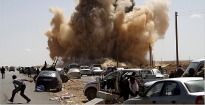Libyan Rebel Lines Breaking Under Qaddafi Onslaught
 The New York Times reports:
The New York Times reports:
RAS LANUF, Libya — Forces loyal to Col. Muammar el-Qaddafitrumpeted their retaking of the rebellious city of Zawiyah near the capital and pressed toward the country’s largest refinery here Friday, as rebel lines began to crumble before an onslaught of airstrikes, tank and artillery fire, and relentless siege.
Plumes of smoke turned clear skies a somber gray after warplanes struck a fuel-storage tank at the refinery and fighters set a dozen tires on fire in a futile attempt to provide cover. Rumors tumbled through dwindling crowds of fighters that spies were among them, and volleys of antiaircraft fire seemed aimed more at lifting people’s flagging spirits than at bringing down the warplanes that sent rebels scurrying for cover behind sand dunes.
The setbacks were the clearest sign yet of the momentum Colonel Qaddafi’s government has seized as it tries to crush the greatest challenge to his nearly 42 years of idiosyncratic rule. Through fear and intimidation, he has silenced protests in Tripoli, ravaged Zawiyah, where the rebels had once delivered the revolt to his doorstep, and brought himself within striking distance of a series of strategic oil towns in eastern Libya.
“We’re exposed here,” said Yusuf Ibrahim, a lieutenant colonel from Benghazi who deserted to the rebel ranks and has tried to coordinate defenses here. “There are no trenches. Do you see any trenches here? This is a wide-open space, and anything is possible.”
“This isn’t an army,” he added.
The advances of Colonel Qaddafi’s forces raised questions of what strategy he might be pursuing in the aftermath of the three-week revolt. Eastern Libya remains tentatively but almost uniformly in opposition hands, and tens of thousands turned out for Friday Prayer, where a cleric urged patience with the revolt. But with the fall of Ras Lanuf and Zawiyah, Colonel Qaddafi is on the verge of retaking installations that refine nearly 90 percent of Libya’s oil production, pumped from the largest reserves in Africa.
Click here to read more.

